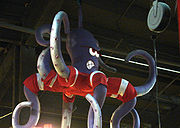
Al the Octopus
Encyclopedia

Mascot
The term mascot – defined as a term for any person, animal, or object thought to bring luck – colloquially includes anything used to represent a group with a common public identity, such as a school, professional sports team, society, military unit, or brand name...
of the Detroit Red Wings
Detroit Red Wings
The Detroit Red Wings are a professional ice hockey team based in Detroit, Michigan. They are members of the Central Division of the Western Conference of the National Hockey League , and are one of the Original Six teams of the NHL, along with the Toronto Maple Leafs, Montreal Canadiens, New York...
of the National Hockey League
National Hockey League
The National Hockey League is an unincorporated not-for-profit association which operates a major professional ice hockey league of 30 franchised member clubs, of which 7 are currently located in Canada and 23 in the United States...
. During some games (usually home playoffs), octopuses are thrown onto the ice by fans for good luck, this usually occurring after the national anthem is sung or after a goal is scored.
This Legend of the Octopus
Legend of the Octopus
The Legend of the Octopus is a sports tradition during Detroit Red Wings home playoff games where octopuses are thrown onto the ice surface. The origins of the activity go back to the 1952 playoffs, when a National Hockey League team played two best-of-seven series to capture the Stanley Cup...
tradition, started on April 15, 1952, when two brothers, Pete and Jerry Cusimano, who owned a fish market, decided to throw an octopus onto the ice at Olympia Stadium, with the eight tentacles of the octopus symbolizing the eight wins it took to win the Stanley Cup at the time. The Red Wings were a perfect 7–0 in the playoffs and were one win away from not only winning the Cup, but becoming the first perfect team in the NHL's post season history. Sure enough the Red Wings won that game, and the media made mention of the octopus "omen" in the papers the following day, thus establishing the octopus legend in the process. Fans have been throwing octopuses onto the ice at Red Wings games ever since. The tradition died down somewhat in the 1970s and 1980s during the Red Wings dismal seasons, but when the Red Wings became contenders again in the '90s, the tradition resumed.
Eventually, a drawn purple octopus mascot was created, and in the 1995 playoffs a large Octopus prop was unveiled. The Octopus was eventually named "Al" (after Joe Louis Arena building operations manager Al Sobotka
Al Sobotka
Al Sobotka is the building operations manager for Olympia Entertainment. His responsibilities include day-to-day operations at both Joe Louis Arena and Cobo Arena. Sobotka is known mostly for driving the Zamboni during Detroit Red Wings games for the past 30 years and for collecting the octopuses...
), and every playoff year since, Al the Octopus gets raised to the rafters, when the Red Wings skate out onto the ice. As the years went on some modifications were made to Al, such as making it so his pupils light up red (blinking on and off), the adding of a large Red Wing Jersey to his body, and the removal of a tooth in order to give Al that "hockey player" look. Al often appears on Red Wings apparel and promotional items. Coca Cola would later create stuffed Als, in their Fan in the Can or Al in the Can promotion. The promotion featured cases of Coke in which some cans were, in fact, containers holding the stuffed Al. Later, Michigan stores would carry the doll, and it would be sold via a mail-in.
There have been many other types of Al merchandise, such as stickers, inflatable dolls, and decals. During the 1996 playoff year, a CD called A Call to Arms was released featuring Al on the cover. Being an octopus, Al's jersey number is 8.
As it now takes 16 wins for the Red Wings to claim the Stanley Cup, there are now two Al's hanging from the rafters when the Red Wings are in the playoffs.

